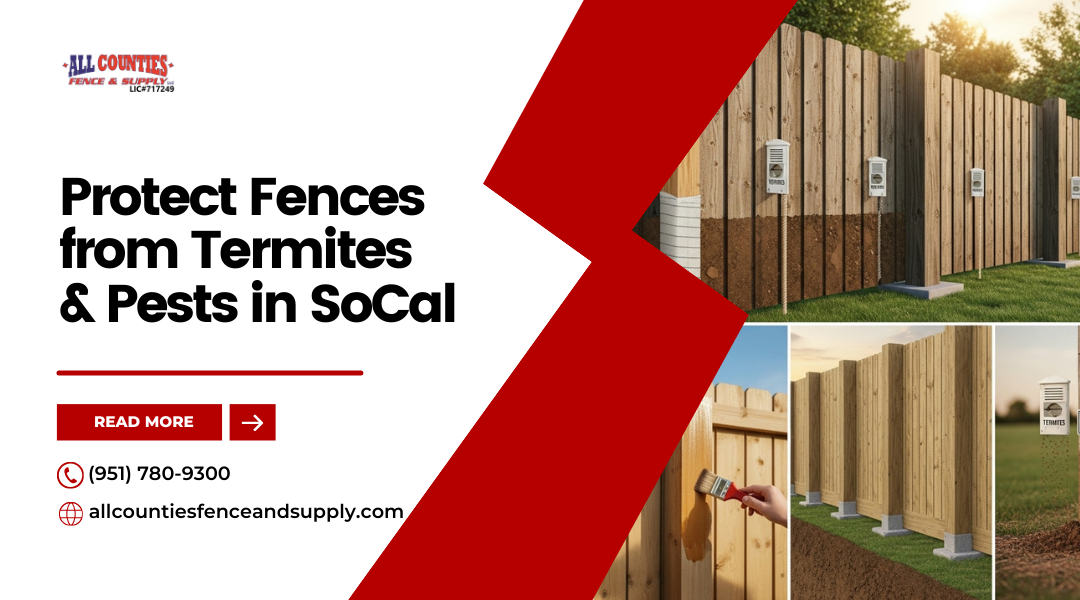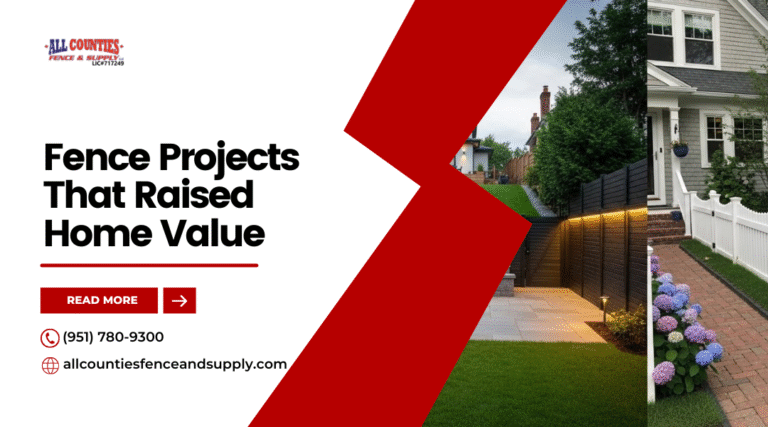Southern California’s warm climate creates the perfect environment for termites and other pests that can silently damage your fence. Left unchecked, these pests weaken wood, compromise structural integrity, and shorten the lifespan of your investment. You can protect your fence by combining smart material choices, proper installation techniques, and consistent maintenance.
When you understand how termites and pests attack different fencing materials, you can take steps to prevent costly repairs. From using treated wood and vinyl alternatives to applying protective barriers, the right approach makes a major difference in how long your fence lasts. Simple actions like routine inspections and early detection give you control before problems spread.
At All Counties Fence & Supply, we’ve helped Riverside homeowners and businesses safeguard their fences for decades. By focusing on durable materials, proven installation methods, and ongoing care, you can keep your fence strong, attractive, and pest-free in the face of Southern California’s unique challenges.
Why Termites and Pests Threaten Southern California Fences
Wood fences in Southern California face constant pressure from insects and pests that thrive in the region’s warm, dry climate. Moisture from irrigation and landscaping practices also creates ideal conditions for infestations that weaken and damage fence structures.
Common Culprits: Subterranean and Drywood Termites, Carpenter Ants and Bees, Powderpost Beetles
Subterranean termites live in soil and build mud tubes to reach fences. They feed on cellulose in wood and can hollow out posts from the inside, making them structurally weak.
Drywood termites don’t need soil contact. They nest directly in dry wood, which makes fence boards and rails especially vulnerable. Their colonies can remain hidden for years before noticeable damage appears.
Carpenter ants don’t eat wood but excavate it to create tunnels. This weakens fence posts over time and may lead to splitting or collapse.
Carpenter bees bore round holes into wood to create nests. While they don’t consume the wood, repeated nesting can cause visible holes and weaken boards.
Powderpost beetles infest unfinished or untreated wood, laying eggs that hatch into larvae. These larvae tunnel through the wood, leaving behind fine powder-like frass and small exit holes.
Rodents may also gnaw on lower fence sections, compounding the damage caused by insects.
How Climate, Irrigation, and Landscaping Increase Risk in Riverside and the Inland Empire
Southern California’s mild winters and long warm seasons allow termites and other pests to remain active year-round. Unlike colder regions, there is little seasonal slowdown, so infestations can spread quickly if not addressed.
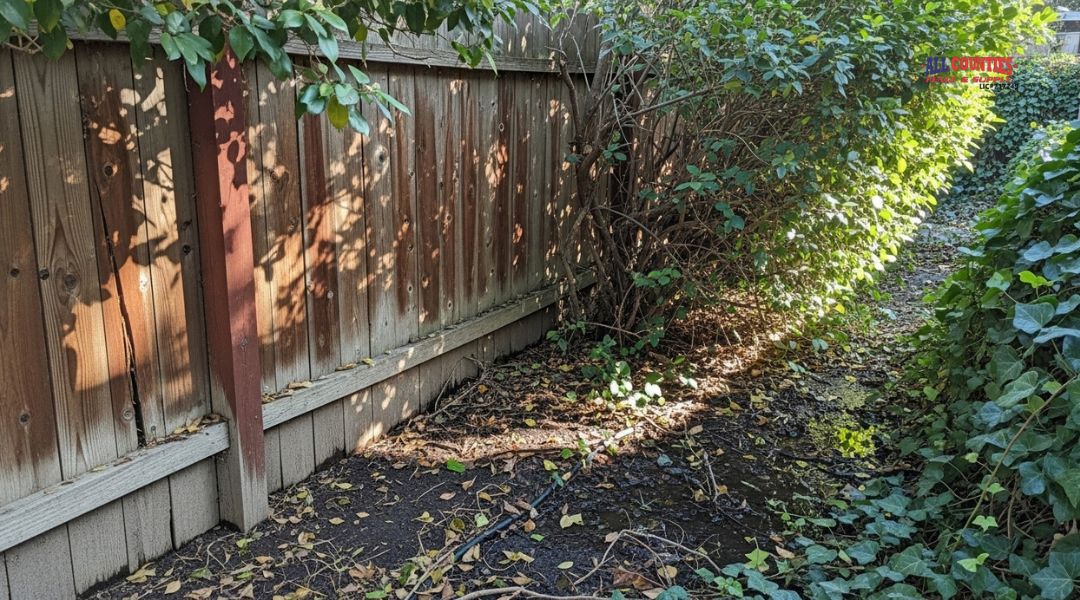
In Riverside and the Inland Empire, irrigation systems often keep soil around fences damp. This moisture attracts subterranean termites and creates decay that makes wood easier for pests to invade.
Dense landscaping, such as shrubs and vines growing against fences, traps humidity and reduces airflow. This creates shaded, moist areas that support both insects and rodents.
Using untreated or unsealed wood in outdoor fencing increases susceptibility. Without protective coatings or barriers, fences absorb water and provide pests with easier entry points.
Even small cracks in boards or posts can become access points for termites, ants, or beetles when combined with favorable environmental conditions.
How Pests Damage Different Fence Materials
Different fence materials face unique risks from insects and animals. Wood attracts destructive pests like termites and carpenter ants, while vinyl and composite resist chewing but can still suffer at posts and joints. Even metal and masonry are not immune, as soil contact, moisture, and nesting activity can create long-term problems.
Wood: Vulnerabilities by Species and Typical Attack Points
Wood fences are the most vulnerable to pest damage. Termites feed directly on cellulose, hollowing out boards from the inside. Carpenter ants don’t eat wood but excavate it to build colonies, leaving piles of wood shavings at the base of posts.
Certain species of wood resist pests better than others. Cedar and redwood contain natural oils that deter insects, while untreated pine or spruce deteriorates quickly. Even pressure-treated lumber can become a target if cracks expose untreated inner layers.
Attack points usually include ground-contact posts, shaded areas with excess moisture, and gaps where vegetation touches the fence. These locations create easy access routes and favorable conditions for insects to thrive. Regular inspection of these areas helps you spot infestations early.
Composite and Vinyl: What Pests Can and Can’t Do, Hidden Risks at Posts and Rails
Composite and vinyl fences don’t provide food for termites or carpenter ants, so direct chewing damage is rare. However, pests can still exploit weak points. Hollow rails and posts may attract insects or small animals looking for shelter.
Moisture buildup inside posts is a hidden risk. If soil or mulch piles against the base, water can collect inside, creating a damp environment where pests nest. This can also weaken the structural insert inside vinyl posts.
Composite fences that use wood fibers in their mix can sometimes attract powderpost beetles or termites if the material is poorly sealed. While the risk is lower than with natural wood, sealing cut ends and keeping debris away from the base reduces exposure.
Metal and Masonry: Corrosion, Nesting in Joints, Soil Interface Issues
Metal and masonry fences resist chewing pests, but they face other challenges. Soil-to-metal contact can accelerate rust, especially if moisture is constant. Rusted areas create weak spots where insects or rodents may burrow nearby.
Masonry fences are not eaten by insects, but small cracks and mortar joints can become nesting sites for ants, spiders, or wasps. Once established, these colonies may expand into surrounding soil or vegetation.
Rodents sometimes dig near the base of chain-link or wrought iron fences, undermining stability. Keeping the soil line clear, sealing cracks, and applying rust-resistant coatings help reduce these risks and extend the life of your fence.
Prevention During Design and Installation
The way you design and install your fence has a direct impact on how well it resists termites and other pests. Careful choices in materials, foundations, soil clearance, and hardware can significantly reduce risk and extend the lifespan of your investment.
Material Selection: Naturally Resistant Species, Pressure-Treated Lumber, Vinyl or Steel Options
Choosing the right fence material is your first line of defense. Some woods contain natural oils and resins that deter termites, including redwood, cedar, teak, and cypress. These species are more durable in Southern California’s climate and require less chemical treatment than softer woods.
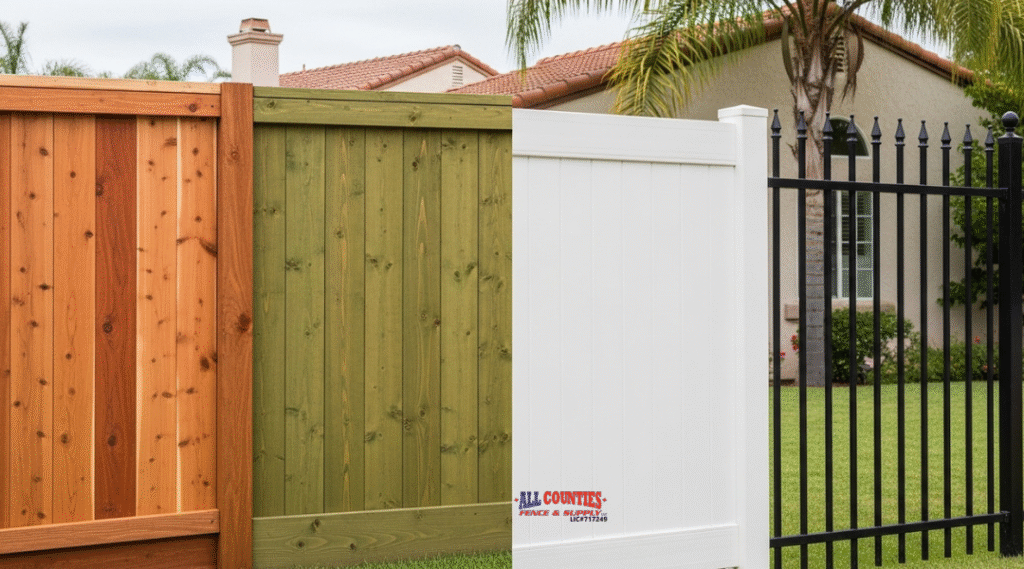
Pressure-treated lumber is another option. It’s infused with preservatives that resist insect damage, though protection weakens over time. If you use this material, plan for resealing or replacing sections as the treatment fades.
Non-wood alternatives like vinyl and steel fencing eliminate cellulose altogether, removing the food source termites rely on. Vinyl offers low maintenance and moisture resistance, while steel provides strength and long-term durability. Both options reduce the need for ongoing pest treatments compared to natural wood.
Post Foundations: Concrete Collars, Gravel Footings, Drainage, Metal Post Bases and Sleeves
Fence posts are the most vulnerable part of your structure because they sit in or near soil where termites thrive. Using concrete collars or gravel footings helps keep posts dry and limits direct wood-to-soil contact. Gravel also improves drainage, reducing standing water that attracts pests.
Proper drainage design is critical. Water should flow away from posts, not pool around them. When possible, slope the concrete top away from the post to shed water.
For added protection, consider metal post bases or sleeves. These elevate wood above grade and act as a physical barrier against termites. In high-risk areas, combining metal sleeves with gravel footings provides both structural stability and pest resistance.
Soil Clearance and Grading: 2–6 Inch Ground Gap, Slope Control, Drip Lines
Keeping wood off the ground is one of the most effective ways to prevent termite damage. Aim for a 2–6 inch clearance between the bottom of fence boards and the soil. This gap makes it harder for termites to access the wood and allows for better airflow.
Grading plays a role as well. Ensure soil slopes away from the fence line to prevent water accumulation. Poor slope control can create damp conditions that attract subterranean termites.
If your property uses irrigation, adjust drip lines and sprinklers so they don’t spray directly onto the fence. Keeping the base of the fence dry reduces both decay and pest activity over time.
Hardware and Joinery: Stainless Fasteners, End-Sealing Cuts, Cap Rails and Post Caps
Termites often exploit small openings in fences, so hardware and joinery details matter. Use stainless steel or galvanized fasteners to prevent rust and maintain tight connections. Loose or corroded fasteners create gaps where moisture and insects can enter.
Whenever you cut or drill into treated or naturally resistant lumber, apply an end-seal preservative to exposed areas. This step protects vulnerable cut surfaces from termite entry and moisture intrusion.
Adding cap rails and post caps provides another layer of defense. They shield horizontal surfaces from rain and irrigation, helping wood dry faster and reducing the likelihood of rot. This small detail extends the lifespan of both posts and panels.
Chemical and Physical Barriers
Protecting a fence in Southern California often requires a layered approach. Treatments that penetrate wood, systems that intercept termites in the soil, and physical barriers that block access all play a role in reducing risks of infestation and long-term damage.
Borate Pre-Treatments and Penetrating Preservatives
Borate solutions penetrate deep into the wood and make it less appealing to termites and other pests. When applied before installation, they create a long-lasting protective layer inside the lumber rather than just on the surface.
This type of treatment is especially useful for fences made from softer woods like pine. Unlike surface coatings, borates reach the inner fibers, which helps protect against hidden damage.
For best results, you should apply borate products to raw, unfinished wood. Once sealed with paint or stain, the treatment becomes locked in. This means you can still finish the fence for weather resistance without reducing termite protection.
Penetrating preservatives, including copper-based formulas, provide additional resistance to decay and insect activity. These treatments extend the service life of posts and rails in direct soil contact.
Bait Stations and Perimeter Monitoring for Subterranean Termites
Subterranean termites are common in Southern California and often attack fences from underground. Bait stations placed around the perimeter target these colonies directly.
Each station contains cellulose material combined with a slow-acting termiticide. Termites feed on the bait and share it with the colony, which helps reduce overall numbers. Unlike sprays, baiting systems focus on colony elimination rather than just surface protection.
Monitoring is essential. You or a pest control professional must check stations regularly to see if termites are active. When activity is found, the bait is replenished until the colony declines.
This method works best as part of an integrated plan. It does not protect the wood itself but reduces pressure from termite populations in the soil.
Stainless Mesh or Sand Barriers and Post Sleeves
Physical barriers prevent termites from reaching your fence without relying on chemicals. Stainless steel mesh installed around posts or bases blocks entry points because termites cannot chew through it.
Graded sand barriers use particles that are too large and dense for termites to move. When placed under or around posts, the sand layer disrupts tunneling behavior.
Post sleeves made from PVC or other durable materials create a protective layer between the soil and the wood. By isolating the vulnerable portion of the post, sleeves reduce moisture absorption and pest access.
These options are especially useful in areas with heavy termite pressure or where chemical use is limited.
When to Involve a Licensed Pest Control Operator
Some termite prevention steps are manageable on your own, but infestations often require professional intervention. Licensed pest control operators have access to stronger termiticides and specialized equipment.
You should contact a professional if you see mud tubes, hollow-sounding posts, or active swarms near your fence. These signs indicate that termites are already established and may be spreading.
Operators can apply soil treatments, install advanced bait systems, or recommend structural modifications. They also provide scheduled inspections, which are valuable in preventing recurring infestations.
Involving a licensed professional ensures that treatments meet California regulations and are applied safely around your property.
Maintenance Plan to Keep Pests Out
Keeping your fence free from termites and other pests requires consistent inspection, proper surface treatment, moisture control, and timely repairs. By staying on schedule with these tasks, you reduce the risk of hidden damage and extend the lifespan of your wood fence in Southern California’s climate.
Quarterly Inspection Checklist for Rails, Posts, Pickets, and Soil Line
Inspect your fence every three months to catch early signs of pest activity or deterioration. Focus on areas where wood meets soil, as termites often enter from below ground. Look for mud tubes, hollow-sounding wood, or soft spots that indicate decay.
Check rails and pickets for cracks or gaps where insects can shelter. Pay attention to joints and fasteners, since these spots often weaken first. If you notice sawdust-like debris, it may signal carpenter ants or termite activity.
Use a simple checklist to stay organized:
- Posts at soil line: probe for softness or hollow areas
- Rails and pickets: check for cracks, gaps, or chew marks
- Fasteners: confirm nails and screws remain tight
- Surface condition: note peeling paint or worn stain
Document each inspection so you can track changes over time and act quickly when new issues appear.
Sealing, Staining, and Repainting Cadence for SoCal UV Exposure
Southern California’s intense sun quickly breaks down unprotected wood surfaces. To prevent cracks and pest entry points, apply a high-quality stain or sealant every 2–3 years. For painted fences, plan on repainting every 4–5 years, or sooner if you see peeling or fading.
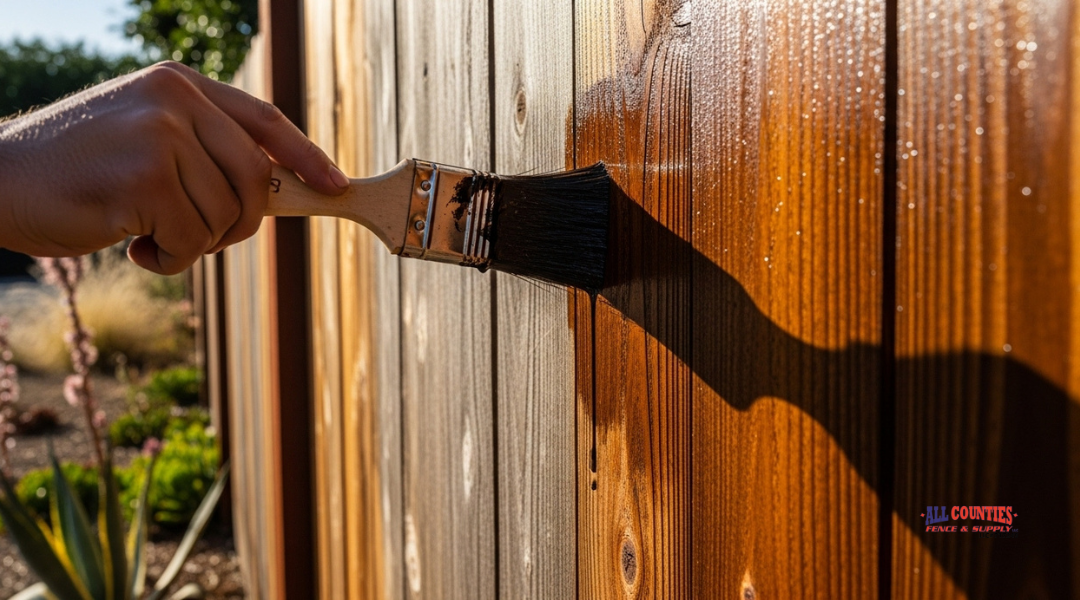
Choose products with UV inhibitors and water resistance. A penetrating oil-based stain often works best for fences because it soaks into the wood and blocks moisture. Clear sealers provide protection but require more frequent reapplication.
Before sealing or painting, clean the fence with a mild detergent and allow it to dry thoroughly. Any dirt or mildew left on the surface will reduce adhesion. Sand rough spots lightly to ensure even coverage.
By following this schedule, you reduce surface wear, limit cracking, and make your fence less vulnerable to termites and rot.
Moisture Management: Irrigation Heads, Mulch Clearance, Plant Spacing
Excess moisture attracts termites and accelerates wood decay. Keep irrigation heads pointed away from your fence to avoid direct spray. Adjust timers so soil near posts does not remain constantly damp.
Maintain at least 2–3 inches of clearance between mulch and the bottom of the fence. Mulch holds moisture and creates a favorable environment for pests. Gravel or stone near the base of posts is a better choice in high-risk areas.
When planting shrubs or vines, leave at least 12–18 inches of spacing between vegetation and the fence. Dense growth traps humidity and hides early signs of infestation. Trim back plants regularly to maintain airflow.
These steps help keep the soil line dry and reduce access points for termites and other pests.
Fast Repair Protocol for Cracks, Rot, and Ground Contact
Small problems can quickly escalate if left untreated. Repair cracks in rails or pickets as soon as you notice them. Use exterior-grade wood filler for minor splits, then sand and reseal the area. For larger cracks, replace the affected board to prevent pest entry.
If you find early-stage rot, cut out and replace the damaged section. Never leave compromised wood in place, as it spreads and attracts insects. For posts showing decay at the ground line, install concrete or steel post bases to lift them above soil contact.
Create a simple repair protocol:
- Identify damage during inspection
- Decide if filler or replacement is needed
- Seal exposed surfaces immediately after repair
- Record the fix in your maintenance log
By acting quickly, you keep your fence structurally sound and far less appealing to termites and other pests.
Early Warning Signs and Diagnostics
Detecting pests early helps you limit structural damage, avoid costly repairs, and decide whether a professional pest inspection is necessary. Careful observation of your fence’s surface, sound, and surrounding soil often reveals problems before they escalate.
Mud Tubes, Frass, Blistered Paint, Hollow Sounds
Subterranean termites often build mud tubes that run along the base of your fence posts or rails. These pencil-sized tunnels protect termites from sunlight and help them reach the wood. If you see them climbing up your fence, it’s a strong indicator of activity.
You may also notice frass, which resembles small piles of sawdust or sand. This is termite droppings being pushed out of tunnels. Unlike natural dirt, frass appears in neat, localized mounds.
Another sign is blistered or bubbling paint. As termites eat the wood beneath the surface, the outer layer may warp or bubble. This is especially noticeable on painted fences.
Finally, tap on the wood. If it produces a hollow or papery sound, termites may have eaten away the interior, leaving only a thin outer shell.
Distinguishing Termite Damage from Carpenter Ants and Bees
Not all wood damage comes from termites. Carpenter ants hollow out wood to create nesting galleries, but they do not eat it. Their tunnels appear smooth and clean, compared to the rough, dirt-filled tunnels of termites.
Carpenter bees drill perfectly round holes, usually about ½ inch wide, often on exposed rails or posts. Unlike termites, they prefer softwoods and typically target unpainted or untreated surfaces.
A quick comparison:
| Pest | Signs of Activity | Damage Pattern |
|---|---|---|
| Termites | Mud tubes, frass, hollow sounds | Rough, soil-filled tunnels |
| Carpenter Ants | Sawdust-like debris, winged ants | Smooth galleries, no soil inside |
| Carpenter Bees | Round entry holes, buzzing near wood | Straight tunnels, minimal spread |
Knowing these distinctions helps you avoid misdiagnosis and ensures you choose the right treatment.
When to Order a Professional Inspection
You should schedule a professional pest inspection if you notice multiple signs at once, such as mud tubes combined with hollow wood. An inspection provides confirmation and identifies the extent of the infestation.
In Southern California, warm weather allows termites and other pests to remain active year-round. Even if you only suspect activity, an inspection can prevent larger structural issues.
Licensed inspectors use moisture meters, probes, and sometimes infrared tools to detect hidden colonies. They can also recommend whether localized treatment or full barrier protection is necessary, giving you a clear plan for protecting your fence.
Treatment Options if Activity Is Found
When termites or other wood-destroying pests are discovered, you need to act quickly to stop further damage. Treatment methods vary in scope, application, and cost, and the right choice depends on the severity of the infestation and the condition of your fence.
Localized Spot Treatments vs Whole-Run Treatments
Spot treatments target specific areas where termites are active. This approach works best if the infestation is limited to a few boards or posts. Liquid termiticides, bait stations, or direct wood injections can be applied to the affected zone, stopping the colony’s access to that section.
Whole-run treatments cover the full length of the fence or a large section of it. This option is more effective if activity is widespread or hidden inside multiple posts. While it costs more upfront, it reduces the risk of missing hidden colonies and provides longer-lasting protection.
| Treatment Type | Best For | Pros | Cons |
|---|---|---|---|
| Spot Treatment | Small, isolated infestations | Lower cost, minimal disruption | May miss hidden colonies |
| Whole-Run Treatment | Widespread or severe infestations | Comprehensive coverage, longer protection | Higher cost, more labor |
Heat, Foam, and Dust Applications with Pros and Cons
Heat treatments use high temperatures to kill termites inside wood. They are chemical-free and effective in contained areas but require specialized equipment and may not reach deep colonies in thick posts.
Foam applications expand into cracks and voids, making them useful for hidden galleries. They deliver termiticide directly where termites live but may not always penetrate large infestations.
Dust treatments involve applying fine insecticidal dust into termite tunnels. They spread effectively within colonies and can eliminate termites over time. However, dust requires precise application and may need multiple treatments.
Comparison at a glance:
- Heat: Non-chemical, immediate results, limited depth.
- Foam: Good for hidden areas, moderate coverage, may need repeat.
- Dust: Spreads through colony, slower results, requires accuracy.
Replace-in-Kind vs Upgrading to Resistant Materials
If termite damage is severe, replacing affected parts of the fence may be necessary. Replace-in-kind means using the same type of wood to match the existing fence. This keeps consistency in appearance but does not add extra protection against future infestations.
Upgrading to resistant materials provides longer-term durability. Options include pressure-treated lumber, cedar, or redwood, which are naturally less attractive to termites. In some cases, homeowners choose to switch to non-wood alternatives such as vinyl or composite fencing, which eliminate the risk of termite damage altogether.
Choosing between replacement types depends on your budget, design preference, and long-term maintenance goals. Resistant materials cost more upfront but reduce the likelihood of repeated infestations and repairs.
Riverside-Specific Tips and Considerations
Protecting a fence in Riverside requires attention to local conditions such as seasonal termite activity, neighborhood property lines, and California’s strict environmental regulations. By planning ahead, you can prevent costly damage while staying compliant with community and state requirements.
Seasonal Timing: Spring Swarmers, Summer Heat, Post-Rain Inspections
In Riverside, termite swarms are most common in spring when temperatures rise and humidity increases. You should plan inspections during this period since swarmers often indicate hidden colonies nearby. Look for discarded wings or mud tubes along the base of your fence.
Summer heat creates dry conditions that may reduce visible activity, but subterranean termites still thrive underground. Regular checks for soil contact or cracks in posts help you spot issues before they spread.
After heavy rains, moisture in the soil attracts dampwood and subterranean termites. Inspect fence posts for softened wood or areas where water pools. A quick inspection within a week of rainfall can prevent long-term damage.
Checklist for timing inspections:
- Spring: Watch for swarmers and wings
- Summer: Monitor soil contact and cracks
- Post-rain: Check for softened or damp wood
HOA and Neighbor Coordination for Shared Fences
If your fence borders another property, you may share responsibility for upkeep. Many Riverside neighborhoods have HOA rules that define how repairs, pest control, and replacements are handled. Reviewing these guidelines helps you avoid disputes.
You should also coordinate with neighbors before scheduling treatments. Termite control is more effective when both sides of a fence are treated at the same time. This prevents pests from moving back and forth across property lines.
Clear communication is key. Document agreements in writing, even if informal, to ensure cost sharing and responsibilities are understood. This avoids delays in addressing infestations and keeps the fence structurally sound.
Safety and California Environmental Compliance Basics
California has strict regulations on chemical use for pest control. If you plan to apply treatments yourself, you must use products approved for residential use and follow label directions carefully. Overuse or misuse can lead to fines or environmental harm.
Professional services in Riverside follow California Structural Pest Control Board standards. Hiring licensed providers ensures treatments meet safety requirements while protecting nearby soil and water.
You should also consider non-chemical methods such as removing wood-to-soil contact or installing metal post bases. These practices reduce risk while keeping you compliant with environmental rules.
When in doubt, consult local guidelines or ask your contractor for documentation on approved treatment methods. This keeps your property protected and compliant at the same time.
Cost, ROI, and Warranty Considerations
Protecting your fence from pests involves weighing the cost of prevention against repair, evaluating the value of different materials, and understanding warranty coverage. Each choice you make directly affects long-term durability, maintenance needs, and overall return on investment.
Upfront Prevention vs Long-Term Repair Costs
Preventative treatments such as termite barriers, chemical soil treatments, or protective coatings add to the initial cost of a wood fence. These measures typically range from $200–$600 depending on fence size and application frequency.
Repairs, however, can be far more expensive. Replacing termite-damaged sections may cost $20–$40 per linear foot, and widespread infestations can require full replacement. In Riverside, where drywood termites are common, ignoring prevention often leads to higher long-term expenses.
You save money by scheduling regular inspections and applying repellents before visible damage occurs. Spending a few hundred dollars upfront can prevent thousands in structural repairs later.
Material Upgrade Economics from Wood to Vinyl, Steel, or Composite
Wood fences are attractive but vulnerable to termites and moisture. Upgrading to vinyl, steel, or composite reduces pest risks and lowers maintenance costs.
- Vinyl: Higher upfront cost but requires little upkeep and is immune to termites.
- Steel: Durable, pest-proof, and secure, though it may need rust protection.
- Composite: Blends wood fibers with plastic for a natural look and improved resistance.
While a wood fence in Southern California may return 50–70% ROI when selling your home, non-wood materials often provide better long-term value. Reduced repair costs and longer lifespans improve your overall return, even if initial installation is more expensive.
Warranties, Service Plans, and Documentation
Fence warranties vary widely by material and manufacturer. Wood warranties may be limited, often excluding termite damage, while vinyl and steel products typically offer longer coverage against structural defects.
You should request written warranties and clarify what is included. Some contractors, including local providers, also offer service plans that cover inspections, re-treatments, or minor repairs.
Keep all documentation for future resale value. Buyers often view transferable warranties as a sign of lower future maintenance costs, which can help your property sell faster and at a stronger price point.
Why Work with All Counties Fence & Supply
Working with a local contractor who understands Riverside’s climate and pest challenges helps you protect your fence investment. You gain precise evaluations, construction practices that meet regulations, and long-term maintenance options supported by trusted regional suppliers.
Site Evaluation and Risk Scoring for Your Property
Before recommending solutions, All Counties Fence & Supply conducts on-site property inspections. These evaluations identify conditions that attract termites and pests, such as soil moisture, wood-to-ground contact, or nearby vegetation.
You receive a risk score that outlines the likelihood of pest damage based on your property’s layout and environment. This scoring system helps you prioritize preventive measures rather than waiting for visible damage.
Inspectors also look at drainage, sun exposure, and existing fence materials. By analyzing these factors, they can recommend whether you need soil barriers, treated lumber, or adjustments to fence placement. This approach ensures your fence design addresses specific vulnerabilities unique to your property.
Code-Compliant Builds with Pest-Resistant Specifications
All Counties Fence & Supply builds fences that meet California building codes while incorporating features that reduce pest risks. Compliance ensures your project avoids costly rework or violations, while pest-resistant specifications extend the fence’s usable life.
For wood fences, the team uses pressure-treated lumber or naturally resistant species like cedar. Metal and vinyl options are also available for areas with high termite activity. Hardware such as galvanized fasteners and concrete-set posts further limit pest entry points.
You benefit from construction practices that go beyond minimum standards. For example, posts are installed with clearance above soil where possible, reducing direct wood-to-ground contact. These small but important details make a measurable difference in long-term durability.
Maintenance Packages and Local Vendor Partnerships
Protecting your fence does not end after installation. All Counties Fence & Supply offers maintenance packages that include scheduled inspections, resealing, and minor repairs to keep your fence structurally sound and pest-resistant.
Through partnerships with local vendors, you gain access to quality sealants, stains, and pest-control treatments at competitive prices. These materials are selected for performance in Southern California’s climate, where heat and seasonal rains can accelerate wear.
Maintenance services also include monitoring for early signs of termite activity. If issues are detected, you receive clear recommendations for treatment before damage spreads. This proactive approach helps you avoid major repairs and preserves the value of your property.

